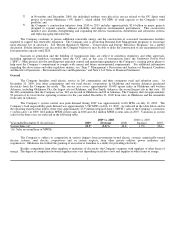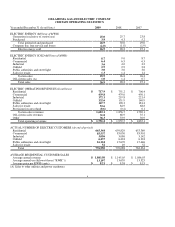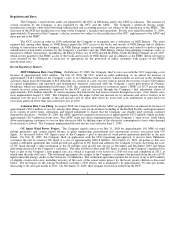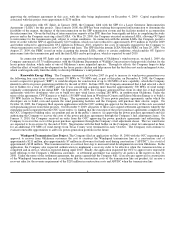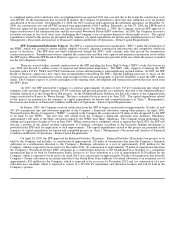OG&E 2009 Annual Report Download - page 17
Download and view the complete annual report
Please find page 17 of the 2009 OG&E annual report below. You can navigate through the pages in the report by either clicking on the pages listed below, or by using the keyword search tool below to find specific information within the annual report.
containing various emissions and operational limitations, install emission control equipment or subject the Company to monetary
penalties, injunctions, conditions or restrictions on operations, and potentially criminal enforcement actions. The Company likely will
be required to incur certain capital expenditures in the future for air pollution control equipment and technology in connection with
obtaining and maintaining operating permits and approvals for air emissions. See “Item 7. Management’s Discussion and Analysis of
Financial Condition and Results of Operations – Environmental Laws and Regulations” for a discussion of potentially significant
environmental capital expenditures related to air emissions particularly as it relates to regional haze.
Water Discharges
The Company’s operations are subject to the Federal Clean Water Act, and analogous state laws and regulations. These laws
and regulations impose detailed requirements and strict controls regarding the discharge of pollutants into state and Federal waters.
The discharge of pollutants, including discharges resulting from a spill or leak incident, is prohibited unless authorized by a permit or
other agency approval. The Federal Clean Water Act and regulations implemented thereunder also prohibit discharges of dredged and
fill material in wetlands and other waters of the United States unless authorized by an appropriately issued permit. Any unpermitted
release of pollutants from the Company’s power plants, pipelines or facilities could result in administrative, civil and criminal
penalties as well as significant remedial obligations. See “Item 7. Management’s Discussion and Analysis of Financial Condition and
Results of Operations – Environmental Laws and Regulations” for a discussion of water intake matters.
Climate Change
Recent scientific studies have suggested that emissions of certain gases, commonly referred to as “greenhouse gases” and
including carbon dioxide and methane, may be contributing to warming of the Earth’s atmosphere. Other nations have already agreed
to regulate emissions of greenhouse gases pursuant to the United Nations Framework Convention on Climate Change, also known as
the “Kyoto Protocol,” an international treaty pursuant to which participating countries (not including the United States) have agreed to
reduce their emissions of greenhouse gases to below 1990 levels by 2012. At the end of 2009, an international conference to develop
a successor to the Kyoto Protocol issued a document known as the Copenhagen Accord. Pursuant to the Copenhagen Accord, the
United States submitted a greenhouse gas emission reduction target of 17 percent compared to 2005 levels. The U.S. Congress is
actively considering legislation to reduce emissions of greenhouse gases. In addition, several states have declined to wait on Congress
to develop and implement climate control legislation and have already taken legal measures to reduce emissions of greenhouse gases.
For instance, at least nine states in the Northeast (Connecticut, Delaware, Maine, Maryland, Massachusetts, New Hampshire, New
Jersey, New York and Vermont) and five states in the West (Arizona, California, New Mexico, Oregon and Washington) have passed
laws, adopted regulations or undertaken regulatory initiatives to reduce the emission of greenhouse gases, primarily through the
planned development of greenhouse gas emission inventories and/or regional greenhouse gas cap and trade programs. Also, as a result
of the U.S. Supreme Court’s decision on April 2, 2007 in Massachusetts, et al. v. EPA, the EPA is taking steps to regulate greenhouse
gas emissions from mobile sources (such as cars and trucks) even if Congress does not adopt new legislation specifically addressing
emissions of greenhouse gases. The enactment of climate control laws or regulations that restrict emissions of greenhouse gases in
areas in which the Company conducts business could have an adverse effect on its operations and demand for its services or
products. The Company reports quarterly its carbon dioxide emissions from generating units subject to the Federal Acid Rain
Program and is continuing to evaluate various options for reducing, avoiding, off-setting or sequestering its carbon dioxide
emissions. Sulfur hexafluoride and methane are also characterized by the EPA as greenhouse gases. The Company is a partner in the
EPA Sulfur Hexafluoride Voluntary Reduction Program, a voluntary program to reduce emissions of greenhouse gases.
In June 2009, the American Clean Energy and Security Act of 2009 (sometimes referred to as the Waxman-Markey global
climate change bill) was passed in the U.S. House of Representatives. The bill includes many provisions that would potentially have a
significant impact on the Company and its customers. The bill proposes a cap and trade regime, a renewable portfolio standard,
electric efficiency standards, revised transmission policy and mandated investments in plug-in hybrid infrastructure and smart grid
technology. Although proposals have been introduced in the U.S. Senate, including a proposal that would require greater reductions
in greenhouse gas emissions than the American Clean Energy and Security Act of 2009, it is uncertain at this time whether, and in
what form, legislation will be adopted by the U.S. Senate. Both President Obama and the Administrator of the EPA have repeatedly
indicated their preference for comprehensive legislation to address this issue and create the framework for a clean energy
economy. Compliance with any new laws or regulations
13


